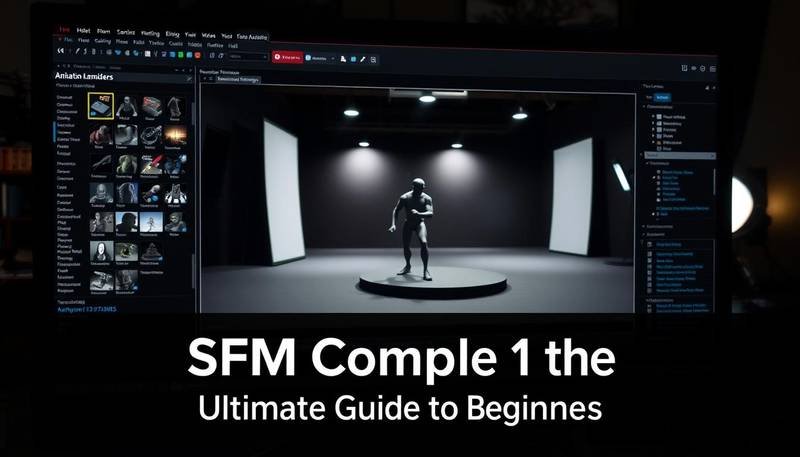What is SFM Compile?
SFM Compile refers to the process of converting raw 3D models, textures, and animations into usable assets inside Source Filmmaker (SFM)—Valve’s powerful cinematic tool based on the Source Engine.
At its core, SFM compile takes various source files (like .smd, .vta, .qc, and textures) and compiles them into .mdl files using Valve’s studiomdl.exe. This is how custom models, props, characters, and animations get imported into the SFM environment.
Why Is SFM Compile Important?
Here’s why SFM Compile is non-negotiable for creators:
-
Brings Custom Content to Life: You can’t use new models in SFM without compiling them.
-
Optimizes for Engine Use: Compiled models are more efficient and engine-friendly.
-
Supports Custom Physics, LODs, and Animations: Enhance realism with physics models or morph animations.
-
Works in Game and Film Projects: A properly compiled asset can work in both SFM and Source Engine games like TF2, CS:GO, and more.
Tools You’ll Need
| Tool | Purpose |
|---|---|
| Blender or 3ds Max | 3D modeling and rigging |
| Crowbar | Decompiler and compiler for Source assets |
| Notepad++ or VS Code | Editing .qc files |
| VTFEdit | Converts textures to Valve’s .vtf format |
| Studiomdl.exe | Valve’s compiler tool |
SFM Compile Workflow
Let’s break the SFM compile process into practical steps:
1. ✅ Prepare Your Assets
You need:
-
Model files (usually
.smdor.dmx) -
Weight-painted skeleton for rigging
-
Morph targets or shape keys for facial expressions (
.vtaif needed) -
Textured materials saved as
.vtfwith.vmtmaterials -
A QC file (compilation script)
Pro Tip: Use Blender Source Tools to export .smd, .dmx, or .vta.
2. Create a QC File (Your Compilation Script)
A .qc (Quake C) file tells studiomdl what to do.
Here’s a basic QC example:
$modelname "models/your_model.mdl"
$bodygroup "body" "your_model.smd"
$surfaceprop "metal"
$cdmaterials "models/yourfolder/"
$sequence idle "your_model.smd" fps 30
$collisionmodel "your_model.smd" {
$mass 10
$inertia 1
$damping 0.1
}
Include:
-
$modelname: Where the compiled model goes. -
$cdmaterials: Texture folder path. -
$sequence: Animations. -
$collisionmodel: Physics for the model.
3. Compile with Crowbar + StudioMDL
Crowbar wraps Valve’s studiomdl for a cleaner interface.
Steps:
-
Open Crowbar → Compile tab
-
Select your
.qcfile -
Set output path (usually under
.../SteamApps/common/SourceFilmmaker/game/usermod/models/...) -
Hit Compile
Crowbar logs everything—super helpful for error tracing!
File Types Used in SFM Compile
| Extension | Type | Purpose |
|---|---|---|
.smd |
Model/Animation | 3D geometry and movement |
.vta |
Vertex Animation | Used for face flexes |
.qc |
Script | Instructs StudioMDL how to compile |
.vtf |
Texture File | Valve’s proprietary image format |
.vmt |
Material Script | Tells Source how to use textures |
Advanced Compilation Techniques
Want more power? Here’s where the pros level up:
Batch Compiling
Instead of compiling one model at a time, use a .bat file to automate multiple compiles:
@echo off
cd "C:\SFM\bin"
studiomdl.exe "C:\SFM\Models\model1.qc"
studiomdl.exe "C:\SFM\Models\model2.qc"
pause
LODs (Level of Detail)
Add multiple LODs to optimize for performance:
$lod 10 "model_lod1.smd"
$lod 20 "model_lod2.smd"
Custom Physics
Make props dynamic with custom .phy setups:
$collisionmodel "model.smd" {
$concave
$mass 50
}Common SFM Compile Errors & Fixes
| Error | Cause | Fix |
|---|---|---|
bad command $sequence |
Syntax error in QC | Check spelling/quotes |
texture not found |
Missing .vtf or wrong path |
Check $cdmaterials |
model has no sequences |
No animations defined | Add $sequence to QC |
Too many bones |
Limit exceeded | Split mesh or simplify rig |
Organizing Output
Compiled models typically go here:
Steam\steamapps\common\SourceFilmmaker\game\usermod\models\yourfolder\
Pro Tip: Use consistent naming like models/custom/character01.mdl.
Make sure matching textures go to:
.../materials/yourfolder/Integration with Source Control
For team projects, integrate your QC scripts and asset source files with Git or Perforce. This allows you to:
-
Roll back changes
-
Track QC or model tweaks
-
Share updates across teams easily
Best Practices for SFM Compile
-
✅ Always test your model in SFM after compiling
-
✅ Keep a clean folder structure
-
✅ Use Crowbar logs to debug compilation
-
✅ Comment your
.qcfiles for clarity -
✅ Backup source files often
-
✅ Use versioning:
model_v1.qc,model_v2.qc, etc.
Case Study: From Blender to SFM
Creator: @DigitalAnimator
Project: A TF2-style animated short with custom weapons
Workflow:
-
Modeled in Blender → Exported
.smd -
Painted UVs → Converted to
.vtfusing VTFEdit -
Wrote custom QC for unique animations
-
Batch compiled 6 models with
.batscript -
Imported to SFM for final cut
Quote:
“SFM Compile lets me bring Blender creations into the cinematic world. It’s a bit of setup, but once you learn it, it’s magical.”
Final Thoughts
SFM Compile is the backbone of custom content creation in Source Filmmaker. Once you understand the flow—model, texture, write QC, compile—you unlock the full power of SFM as a cinematic storytelling tool.
Whether you’re animating memes, machinima, or full-blown digital shorts, mastering SFM Compile gives you freedom, control, and limitless creativity.
✅ TL;DR – Quick Checklist
-
Prepare model
.smd,.vta, textures -
Write a clean QC script
-
Use Crowbar to compile via studiomdl
-
Debug and fix any errors
-
Test in SFM and iterate
Frequently Asked Questions (FAQs)
Q: Can I use Blender with SFM Compile?
Yes. Blender Source Tools allow exporting .smd and .vta files compatible with studiomdl.
Q: Is Crowbar required?
No, but it simplifies the process. You can use studiomdl via command line too.
Q: Why isn’t my model showing in SFM?
Double-check paths, texture folders, and ensure .mdl is in the correct usermod/models/ folder.
